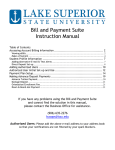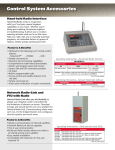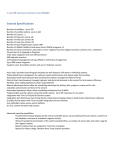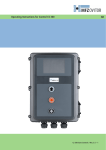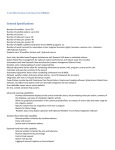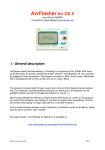Download Digital E Series Operating instructions
Transcript
E-Series Satellite Controller OSMAC Digital Wireless Paging System (Narrow Band) Installation and Operating Instructions Introduction The E-Series satellite controller with OSMAC Digital Wireless Paging is designed for installation on a substantial concrete foundation with imbedded conduit of various diameters to enable power, field and earth ground wiring to be routed into the cabinet. A mounting bolt positioner and basic mounting hardware components are included with each controller. Additional materials required to complete the installation must be obtained separately. A material list can be compiled by reading through the instructions completely prior to starting the installation. CAUTION: For your protection and the safety of the product user, comply with all Caution and Warning statements within this document. All installation practices must comply with all applicable national and/or local electrical and construction codes. Foundation Construction 1. Prepare a hole for the foundation and wiring conduit using the minimum recommended dimensions shown in Figure 1. *Note: Refer to local electrical codes for required depth of buried wiring. 2. Trench to the foundation site as required for each wiring run. 3. Position straight and sweep elbow conduit sections in foundation hole as shown. Tape the conduit ends to seal out dirt. Backfill soil to form a 6" (15.2cm) foundation depth. Conduit should not extend more than 2" above the finished top surface of the foundation. 4. Prepare the sides of the foundation hole with wood forms. 5. Prepare the mounting bolt positioner with the 5/16 x 4-1/2" bolts and nuts (provided) as shown in Figure 1. The threads should extend 2" (51mm) from the top surface of the bolt positioner. 6. Pour concrete into the formed foundation hole. Press the mounting bolt positioner into the concrete until it is flush and level with the foundation surface and aligned with the conduit. 7. Finish the concrete with a level flat area for the pedestal base (13" x 13" [33cm x 33cm] for the metal cabinet or 16" x 16" [41cm x 41cm] for the plastic cabinet). To prevent pooling at the base of the pedestal, add a slight taper away from the cabinet base contact area. Allow concrete to sufficiently harden before continuing. 8. Remove the hex nuts from the mounting bolts. Place the pedestal on the pad ensuring all bolts pass though the holes provided. Install a flat washer and a hex nut on each bolt and tighten securely. Figure 1 Wood Form Plastic Cabinet Base Area Metal Cabinet Base Area Mounting Bolt Positioner 3" (76mm) Conduit – Field (32 Stations Each) 30" (76cm) 3/4" (19mm) Conduit – Earth Ground 3/4" (19mm) Conduit– AC Power 2" (51mm) Max. FRONT 30" (76cm) Taper 6" (15.2cm) Mounting Bolt Positioner See *Note 2" (51mm) Mounting Bolt w/ Hex Nuts (Typical 4 Places) Concrete Earth Ground Installation Important! The satellite surge protection components cannot properly function unless an efficient pathway to earth ground is provided. The ground path must be as direct as possible, without sharp bends and must not exceed 30 ohms resistance (when measured with an earth ground resistance test device). A resistance reading of 0–10 ohms is considered excellent, 11–20 ohms is acceptable and 21–30 is considered marginal. All electrical components throughout the irrigation system should be grounded in a manner which provides the same ground potential. The following instructions depict one of several acceptable earth grounding methods. Due to variables in soil composition and terrain, the method shown may not be suitable for your installation site. Contact your local Toro distributor for assistance and availability of the required earth ground resistance test instrument. Recommended ground testers are: AEMC Instruments, model 3710 clamp-on tester, or Biddle Megger, model 250260 (or equivalent). Procedure 1. Drive a 5/8" (16mm) by 8' (2.5m) copper-clad steel rod into well-moistened soil not more than 12' (3.7m) from the satellite. The top of the ground rod should be slightly below grade level. 2. Using a 5/8" (16mm) clamp or “Cad weld” fastener, attach a length of #6 (6mm2) solid copper wire near the top of the ground rod. Avoiding sharp bends, route the wire through the foundation into the controller cabinet. Secure the wire to the large copper ground lug provided on the power supply chassis. See Figure 2. Note: Make sure the soil surrounding the ground rod(s) remains well moistened at all times. The addition of some form of irrigation may be required if the satellite is installed in a non-irrigated location. Figure 2 850-00 Valve Cover Ground Wire To Additional Ground Rod(s) (Optional) Chassis Ground Lug #6 (6mm2) Solid Copper Ground Wire WARNING HIGH VOLTAGE 115V Copper-Clad Ground Rod 12' (3.7m) Maximum 3. Measure the ground resistance per the instructions provided with the ground test instrument. If the resistance exceeds the acceptable limit, additional ground rod(s) can be installed at a distance equal to twice the buried depth of the first rod; i.e., 16' (4.9m). Interconnect the ground rods using #6 (6mm2) solid copper wire and test again. If the measured ground resistance continues to read above the acceptable limit, contact your local Toro distributor for further assistance and recommendations. Note: A Toro Valve Cover, P/N 850-00, works well for covering the ground rod and providing access to the ground wire connection(s). Input Power Installation CAUTION: When installing multiple controllers, polarity of the Line and Neutral connections must be properly maintained throughout the irrigation system. Reversed polarity may cause damaging potentials to exist at one or more controller locations. An equipment ground wire from the power source must also be connected to the satellite power supply terminal block. WARNING AC POWER WIRING MUST BE INSTALLED AND CONNECTED BY QUALIFIED PERSONNEL ONLY. ALL ELECTRICAL COMPONENTS AND INSTALLATION PROCEDURES MUST COMPLY WITH ALL APPLICABLE LOCAL AND NATIONAL ELECTRICAL CODES. SOME CODES MAY REQUIRE A MEANS OF DISCONNECTION FROM THE AC POWER SOURCE, INSTALLED IN THE FIXED WIRING, HAVING A CONTACT SEPARATION OF AT LEAST 0.120" (3MM) IN THE LINE AND NEUTRAL POLES. ENSURE THE AC POWER SOURCE IS OFF PRIOR TO CONNECTING TO THE CONTROLLER. 2 Input Power Installation (continued) Procedure 1. Place the controller’s main power switch in the Off position. See Figure 3. 2. Position the input voltage select switch to the 115V (for 115-120V service) or 230V (for 230-240V service) as required. 3. Remove the power wiring access cover located on the back of the power supply assembly. See Figure 4. Note: The power and equipment ground wires are connected to a terminal block located on the back of the power supply assembly. The power wire access hole provided will accommodate a 3/4" (19mm) conduit fitting. If conduit is required by code, install a section of flexible 3/4" (19mm) electrical conduit from the foundation conduit to this access hole. 4. Route the appropriate size 3-conductor cable (10 AWG [2.5mm2] maximum) from the power source location to the power supply terminal block. 5. Reference Table 1 for the appropriate type of power connection. Secure the wires to the terminal block as indicated in Figure 4. 6. Reinstall the power wiring access cover. 7. Apply power to the controller. Figure 3 WARNING HIGH VOLTAGE 3.2A Fuse – Station Output On Off Main Power Switch/ 1.5A Circuit Breaker 115V 4.0A Circuit Breaker – Control Functions Input Voltage Select Switch Table 1 Line AC Service Type 115/120 V a.c. 50/60 Hz (Dom.) Equip. Grnd. Hot (Black) 230/240 V a.c. 50/60 Hz (3-Phase) Hot (Black) 230/240 V a.c. 50/60 Hz (Int) Neutral Green Neutral (White) Green/Yellow Hot (Blue or Red) Hot (Brown) Green/Yellow Neutral (Blue) Equipment Ground Figure 4 Neutral Line Note: The satellite incorporates a 24 V a.c. Hot Post feature on each station output module which enables control valves to be identified through momentary activation. To utilize the Hot Post feature, the satellite power supply must be switched on. If you do not wish to use the Hot Post feature, leave the controller’s main power switch Off until the installation has been completed. See page 4, Figure 6. Cover (Side View) 3/4" (19mm) Conduit (Optional) Field Wire Installation CAUTION: The E-Series OSMAC satellite is capable of operating up to 12 stations simultaneously when operating with pump, or 16 stations simultaneously without a pump. To prevent possible controller damage, total output current load must not exceed 3.2 amps. If more than one valve per station will be connected, calculate the total in-rush current load which would be imposed in the maximum operating conditions and use this value as a guide during installation and operation of the controller. Procedure 1. Attach the control and common wires to each valve and/or valve-in-head solenoid leads using an approved waterproof splicing method. Route the wires into the controller cabinet through the 3" (76mm) conduit. 2. If automatic pump start is required, refer to the applicable wiring diagram in Figure 5 (page 4) and install accordingly. Caution: Do not connect the pump starter directly to the controller’s pump start circuit – damage to the controller will result. Note: The pump circuit can also be utilized to control a master valve if required. 3 Field Wire Installation (continued) 3. Secure the field common wire(s) and pump start relay (or master valve) wire to the appropriate terminals on the Pump/Com module. See Figure 6. 4. Momentarily touch each valve control wire to the Hot Post to activate and identify the corresponding valve(s). Figure 5 Pump Power Source Single Controller Pump Com Starter Power Source Multiple Controllers Magnetic Pump Starter To Other Controllers Relay 5. Secure the valve control wires to the staPump 24 V a.c. Pump Power tion terminals in the preferred order of 1A Max. Source Pump Com operating sequence. Station terminals are Mag. numbered left to right, 1–32 (front) and Pump Pump Starter 33–64 (back). Each terminal can accomPressure Switch With Starter 2 Controller Override Com Power modate two 14 gage (1.5mm ) solid copper Relay Source wires. See Figure 6. Pressure Switch Pump Power 24 V a.c. Pump Source Note: A loop is provided on the plastic chas1A Max. (Typical) Magnetic sis below each output module enabling a Pump wiring strain relief to be installed when the Starter Pump Starter optional standard terminal block connector Power Com is used. After connecting the field wires, Source Relay install a nylon cable tie through the loop and 24 V a.c. 1A Max. Pump around the wire bundle. Ensure the terminal block is properly mated with the output module connector after tightening the cable tie. See Figure 6. Note: The 3-position switches Figure 6 Field Common provided on the pump/com mod24 V a.c. Output LED Indicator Field Common ule and the optional station terLED Indicators Control Switch minal board enable local control (one per station) of the field common, pump circuit Field Common and station output. The switch LED Indicator positions are as follows: Pump Circuit ON (up) – Manually activates the LED Indicator circuit. The pump, field common 3A Fuse or station output will remain on 24 V.a.c. Output (Station Output) until the switch is moved to the LED Indicator (fuse condition) AUTO or OFF position. 24 V a.c. OFF (center) – Manually opens Output LED the circuit. Operation of the circuit Indicator will not occur while the switch is in this position. 1A Fuse 24 V a.c. (Pump Circuit) AUTO (down) – Enables the circuit Hot Post to be automatically controlled Pump Circuit Standard during automatic or manual Control Switch Terminal Block (hand-held radio) operation. Station Output CAUTION: To prevent damage to the station output circuit fuse, do not exceed 3 amp load when manually activating multiple station outputs. Switches (optional) Pump Output LED Indicator Field Common Terminals (3) Pump Relay Terminal Station Output Terminals Cable Tie Strain Relief 4 (optional) Selecting the Decoder Radio Frequency The narrow band decoder module assembly stores four user-selectable radio frequencies. The frequencies are programmed at the factory or by the distributor prior to delivery of the satellite. A set of jumper pins, located at the top center of the decoder module, enables the frequency to be selected by simply placing the jumper on the appropriate pin set. In most cases, the jumper will be configured properly by the distributor prior to delivery. However if a frequency change is desired, place the jumper on the pin set as indicated in Figure 7. Figure 7 #4 #3 #2 #1 Frequency Number Jumper Pins Important: The base station transmitter and decoder must be set to the same frequency to enable communication. Assigning the Satellite Address Number Each satellite requires a 3-digit address number to enable communication with the central controller and/or a hand-held radio. The address numbers range from 1 (001) through 255 and are issued to the satellite through an array of eight DIP switches, located on the decoder module assembly. See Figure 8. In the down position, the switch is Off (open) and represents a value of 0 (zero). In the up position, the switch is On (closed) and represents the following address number: Sw 1 = 1 Sw 2 = 2 Sw 3 = 4 Sw 4 = 8 Sw 5 = 16 Sw 6 = 32 Sw 7 = 64 Sw 8 = 128 To set the satellite address number, place the switch or combination of switches to the On position which provides the numerical equivalent of the desired address number. For example: To set satellite address number 50 (050), start with all eight DIP switches in the Off (open) position, then close switch numbers 2, 5 and 6; i.e., 2 (Sw 2) + 16 (Sw 5) + 32 (Sw 6) = 50. Figure 8 DIP Switch Array O1 2 3 4 5 6 7 8 N Note: The narrow band satellite utilzes a built-in antenna located on the frequency module assembly. If site conditions are such that an alternate antenna is required, the optional antenna adapter kit (P/N 102-1204) is required. Testing Satellite Operation • Performing a Control Circuit Self Test A self-test feature is provided to check the functionality of various key satellite control circuits. Before performing the test, ensure the Field Common, Pump and Station Output control switches are set to the AUTO (down) position. The test is initiated by positioning the TEST/RESET switch, located on the decoder module, to the TEST position as shown in Figure 9. Testing will begin immediately and is indicated by the audible clicks of the control relays and momentary illumination of the LED’s on the various PCB assemblies. The test will repeat continuously until the TEST/RESET switch is positioned to the center (normal operation) position. Note: The RESET position resets the decoder microprocessor to factory defaults. To take affect, the satellite must be powered up with the switch in the RESET position. The switch should be placed in the NORMAL position after 15 seconds of operation. Figure 9 • Performing a Station Output Test Ensure the Field Common control switch is in the AUTO or ON position and the Pump Circuit control switch is set to the appropriate position. One at a time, position each Station Output control switch (if this option is installed) to the ON position and confirm sprinkler operation. 5 Satellite Operations Using a Hand-Held Radio The following list of satellite operations can be initiated in the field using a hand-held radio keypad. All operation commands must begin with the following keypad sequence: 9 followed by the 3-digit satellite address number. The command code is then entered, followed by additional digits which represent selected stations and/or run time values. All station numbers from 1–9 must be entered with a preceding 0; i.e., station 1 is entered as 01. Example: Confirm communication to the satellite by issuing a manual station start command as follows: Press 9 , the 3-digit satellite address code, command code 7521 and 01 (station 1). The LED indicator on the decoder module should turn off momentarily. An audible click should be heard from the station relay and the corresponding station output LED should turn on. Visually check for sprinkler operation. To step forward through the stations, press 1 ; to step back through the stations, press 2 . To terminate the test, use command code 7520. * * Command Code 7510 7511 7512 7513 7514 7515 7516 7517 7518 7520 7521 7524 7525 7526 7540 7543 7544 7546 8000 8001 8003 00 8003 01 8004 * * Operation Description Turns off individual stations; e.g., 7510 01 02 40 turns off stations 1, 2 and 40. Turns on individual stations; e.g., 7511 01 02 40 turns on stations 1, 2 and 40. Syringes individual stations for a predetermined number of 30-second intervals (already defined in the satellite); e.g., 7512 01 02 turns on stations 1 and 2 for 30-second intervals. Disables individual stations; e.g., 7513 01 03 disables stations 1 and 3. After this command, on and off commands will be ignored for stations 1 and 3 until the stations are re-enabled. (See 7514.) Enables individual stations; e.g., 7514 01 03 enable stations 1 and 3. Sequentially syringes a specified station number range; e.g., 7515 10 20 will syringe stations 10 through 20 sequentially. Sequentially syringes individual stations; e.g., 7516 10 11 will syringe stations 10 and 11. Multiple syringe groups can also be run. Enter two dashes between stations to designate separate syringe groups; e.g., 7516 10 11 - - 22 24 26 28 will run two sequential syringes at the same time on stations 10 and 11 and stations 22, 24, 26 and 28. Turns on individuals stations for a specified number of hours, minutes and seconds; e.g., 7517 01 30 00 23 24 25 turns stations 23, 24 and 25 on for 1 hour, 30 minutes and no seconds. Turns on individual stations for a specified number of minutes; e.g., 7518 10 23 24 25 turns on stations 23, 24 and 25 for 10 minutes. Turns off a sequential station run operation (initiated by command code 7521). Turns on a sequential station run operation; e.g., 7521 01 turns on station 1. To step forward through the stations, press 1 ; to step back through the stations, press 2 . Turns on individual stations as switches; i.e., does not simultaneously energize the pump. Note: Will not turn off the pump if already running. E.g., 7524 25 35 45 turns on stations 25, 35 and 45 without energizing the pump. Turns on individual stations as switches for a time given in minutes; i.e., does not simultaneously energize the pump in this command string, the run time is entered first, followed by the station numbers; e.g., 7525 25 05 42 turns on stations 5 and 45 for 25 minutes without energizing the pump. Turns on individual stations as switches for the time given in hours, minutes and seconds. In this command string, the run time is entered first, followed by the station numbers; e.g., 7526 02 30 45 25 26 27 turns on stations 25, 26 and 27 for 2 hours, 30 minutes and 45 seconds. Turns off all stations (this satellite only). Disables all stations in all satellites (rain shutdown). Note: Satellite address code is not used with 7543 or 7544 command codes. The stations will not respond to any further commands until enabled. Enables operation of all stations in all satellites. See Note above. Sequentially syringes all stations for a set length of time; e.g., 7546 turns on all stations for the predetermined number of 30 second intervals as defined in the syringe time. Disables pump start. Enables pump start to be assigned to a station; e.g., 8001 48 assigns pump start to station 48. Disables operation and turns off all stations in the satellite with sequential shutdown. Enables operation of all stations in the satellite. Changes the password; e.g., 8004 7531 6108 will change the factory default password (7531) to 6108. * * 6 Command Code 8006 01 8006 02 8006 03 8008 8009 8011 Operation Description Sets the syringe time in 30-second intervals; e.g., 8006 01 0100 (without a password) or 8006 pppp 01 0100 (with a password) sets the syringe time to 100 intervals (50 minutes). The number of intervals must be given as four digits with leading zeros but can be no greater than 0255. Sets the time-out limit in 30-minute intervals. This must be specified using four digits with leading zeros and no greater value than 0255; e.g., 8006 02 0060 (without a password) or 8006 pppp 02 0060 (with a password) sets the time-out limit to 30 hours. Enables/disables the password. Use 8007 03 01 to enable password protection or 8007 03 00 to cancel password protection. Configures stations as switches. Stations can be specified individually and in combination with a range of stations; e.g., 8008 01 12 50 – 60 configures stations 1, 12 and 50 through 60 as switches. Note: Only a single dash is used when entering a range of stations. Configures stations for irrigation. Stations can be specified individually and in combination with a range of stations; e.g., 8009 01 20 45 – 48 configures stations 1, 20 and 45 through 48 for irrigation. Resets EPROM to factory defaults. Installing Additional 8-Station Output Modules The E-Series OSMAC satellite can be upgraded to a maximum of 64 station outputs with the addition of 8-station output modules and optional terminal boards. The station module is supplied with the required mounting hardware and connector cable. Note: Each of the eight output module positions has a specific station number assignment. An output module can be installed in any open position. The controller recognizes the module station order as follows: (Front, left to right) Module position 1 = Stations 1–8 Figure 10 Output Distribution Module position 2 = Stations 9–16 Board Module position 3 = Stations 17–24 Backplate Latch Module position 4 = Stations 25–32 (Back, left to right) Module position 1 = Stations 33–40 Module position 2 = Stations 41–48 Ribbon Cable Module position 3 = Stations 49–56 Module position 4 = Stations 57–64 Installation Procedure (Refer to Figure 10) 8-Station 1. Switch power supply Off. Output Module 2. Place the 8-station module onto the backplate, positioning it between the four guideposts. Machine Carefully press inward at the top of the module Screw* board to engage the plastic latch. 3. Ground and secure the module to the backplate assembly using the single machine screw provided. Self-Tapping *Important: The machine screws connect the output Screws and station modules to the 24V power and ground bus bars and must be installed in the designated locations as indicated in Figure 10. Do not attempt to use self-tapping screws in these locations. 4. Install the ribbon cable to the 8-station module and Machine Standard-Station output distribution board receptacles as shown.The Screws* Output Terminal ribbon cable connectors are keyed to insert lin one Block direction only. Self-Tapping Optional Station Output 5. Insert the optional station output terminal board Screw Terminal Board Assembly assembly connector or standard terminal block to the station module receptacle. Secure the terminal board assembly to the chassis with three self-tapping screws and two machine screws provided. 6. Connect the valve wiring as described on page 4. 7. Switch power supply On. 7 Specifications Line Voltage: 115-120 or 230-240 V a.c. 50/60 Hz (switchable), 130 VA Current Draw (no load): 0.21A @ 115-120 V a.c., 60 Hz or 0.10A @ 230-240 V a.c., 50 Hz Current Draw (maximum load): 0.91A @ 115-120 V a.c., 60 Hz or 0.45A @ 230-240 V a.c., 50 Hz Secondary Voltage Output: 24 V a.c., 50/60 Hz, 3.0A (85 VA) Maximum Load Per Station Output: 0.75A (18 VA) Maximum Load Per Pump/Master Valve Output: 1A (24 VA) Maximum Load Per Pump/Master Valve Output: 1A (24 VA) Operating Temperature: -10°C to +60°C (14°F to 140°F) Storage Temperature: -30°C to +65°C (-22°F to 149°F) Hardware Features Plastic or painted stainless-steel cabinetry Front, back and top locking covers Modular station output capacity upgradeable in 8-station increments. (48-station maximum when used in conjunction with TouchNet; 64-station maximum with SitePro.) Optional output terminal board configurations in 16-station increments Optional antenna adapter kit available. Order kit number 102-xxxx. Fuses and Circuit Breakers Power Supply: 1.5A On/Off Switch/Circuit Breaker – Main Power Input 3.2A Fuse – Power Supply (Slow Blow) 4.0A Circuit Breaker – Control Functions Control Modules: Pump – 1.0A Fuse (Fast Blow, Automotive Type) Station Output – 3.0A Fuse (Fast Blow, Automotive Type) WARNING IF FUSE REPLACEMENT IS REQUIRED, REPLACE WITH A FUSE OF THE SAME TYPE AND AMPERAGE RATING. FAILURE TO COMPLY CAN RESULT IN SERIOUS INJURY AND/OR EQUIPMENT DAMAGE DUE TO FIRE HAZARD. Electromagnetic Compatibility Domestic: This equipment generates and uses radio frequency energy and if not installed and used properly, that is, in strict accordance with the manufacturer's instructions, may cause interference to radio and television reception. It has been type tested and found to comply with the limits for a FCC Class B computing device in accordance with the specifications in Subpart J of Part 15 of FCC Rules, which are designed to provide reasonable protection against such interference in a residential installation. However, there is no guarantee that interference will not occur in a particular installation. If this equipment does cause interference to radio or television reception, which can be determined by turning the equipment off and on, the user is encouraged to try to correct the interference by one or more of the following measures: • Reorient the receiving antenna. • Relocate the irrigation controller with respect to the receiver. • Move the irrigation controller away from the receiver. If necessary, the user should consult the dealer or an experienced radio/television technician for additional suggestions. The user may find the following booklet prepared by the Federal Communications Commission helpful: "How to Identify and Resolve Radio-TV Interference Problems." This booklet is available from the U.S. Government Printing Office, Washington, DC 20402. Stock No. 004-000-00345-4. International: This is a CSPR 22 Class B product. © 2000 The Toro Company, Irrigation Division Form Number 373-0122 Rev B








